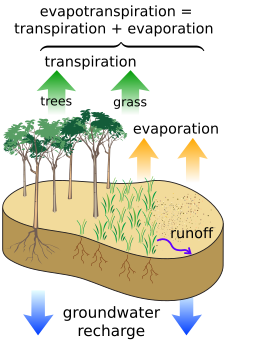
Back نتح تبخري Arabic Evapotranspiració Catalan Evapotranspirace Czech Evapotranspiration Danish Evapotranspiration German Vaporiĝ-transpiro Esperanto Evapotranspiración Spanish Evapotranspiratsioon Estonian Ebapotranspirazio Basque تبخیر-تعرق Persian


Evapotranspiration (ET) refers to the combined processes which move water from the Earth's surface (open water and ice surfaces, bare soil and vegetation) into the atmosphere.[2] It covers both water evaporation (movement of water to the air directly from soil, canopies, and water bodies) and transpiration (evaporation that occurs through the stomata, or openings, in plant leaves). Evapotranspiration is an important part of the local water cycle and climate, and measurement of it plays a key role in water resource management agricultural irrigation.[3]
- ^ Brun, Philipp; Zimmermann, Niklaus E.; Hari, Chantal; Pellissier, Loïc; Karger, Dirk Nikolaus (16 December 2022). "Global climate-related predictors at kilometer resolution for the past and future". Earth System Science Data. 14 (12): 5573–5603. Bibcode:2022ESSD...14.5573B. doi:10.5194/essd-14-5573-2022. ProQuest 2754820718.
- ^ IPCC 2023a, p. 2908.
- ^ Singh, Prachi; Srivastava, Prashant K.; Mall, R.K. (2021). "Estimation of potential evapotranspiration using INSAT-3D satellite data over an agriculture area". Agricultural Water Management. pp. 143–155. doi:10.1016/B978-0-12-812362-1.00008-4. ISBN 978-0-12-812362-1.
Evapotranspiration is considered as one of the most important components of the hydrological cycle. On the Earth's surface, evapotranspiration plays an important role in context of water-energy balance and irrigation, as well as agriculture practices.
© MMXXIII Rich X Search. We shall prevail. All rights reserved. Rich X Search